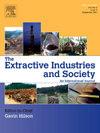The development of borax mining in the Salar de Ascotán and the production of an ecological subsidiarity: origins, tax exemptions, and the decimation of yareta (1880-1915)
IF 4.3
2区 社会学
Q2 ENVIRONMENTAL STUDIES
Extractive Industries and Society-An International Journal
Pub Date : 2025-06-07
DOI:10.1016/j.exis.2025.101695
引用次数: 0
Abstract
From the late nineteenth and early twentieth centuries onward, the Salar de Ascotán, in northern Chile, was redefined by the mining economy which transformed the watershed into a great borax mining zone. Not only did this high-altitude zone become part of Chilean territory as a result of the War of the Pacific (1879–1884); it was also annexed into the global mining and natural resource extraction circuits that supplied the world’s major industrial centers, demonstrating the key role of this salt flat in perpetuating the logic of mining colonization pursued a certain foreign mining consortium. This article focuses on the early period of borax production, which not only required logistical infrastructure but also had a severe ecological impact. The emergence of extractivism in Ascotán can be broken down into four main aspects: 1) the reshaping of the territory as a result of the war, 2) the extraction and sale of its natural resources, 3) corporate profit amassed thanks to tax exemptions, and 4) unencumbered access to the salt flat’s surrounding ecosystems, particularly the impacts on and decimation of yareta (Azorella compacta) reserves in those areas. This process was a component of what we call an ecological subsidiarity, which resulted in the legal use and decimation of ecosystems, which were redefined as resources for the purpose of satisfying the demand for minerals. This demonstrates how extractivism was able to burst onto the scene in an arid, high-altitude region that has been misunderstood as an isolated periphery of capitalist expansion in northern Chile.
Ascotán盐湖硼砂开采的发展和生态辅助产品的生产:起源、免税和亚雷塔的大量砍伐(1880-1915)
从19世纪末和20世纪初开始,智利北部的Ascotán盐湖被采矿经济重新定义,将分水岭变成了一个巨大的硼砂矿区。这片高海拔地区不仅因为太平洋战争(1879-1884)而成为智利领土的一部分;它还被纳入了供应世界主要工业中心的全球采矿和自然资源开采回路,这表明了这个盐滩在延续某个外国采矿财团所追求的采矿殖民化逻辑方面的关键作用。硼砂生产初期不仅需要物流基础设施,而且生态影响严重。开采主义在Ascotán的出现可以分为四个主要方面:1)由于战争对领土的重塑,2)开采和出售其自然资源,3)由于免税而积累的公司利润,以及4)无限制地进入盐滩周围的生态系统,特别是对这些地区的雅雷塔(Azorella compacta)保护区的影响和破坏。这个过程是我们所说的生态辅助性的一个组成部分,它导致了对生态系统的合法使用和破坏,生态系统被重新定义为满足矿物需求的资源。这证明了采掘主义是如何在一个干旱的高海拔地区突然出现的,这个地区一直被误解为智利北部资本主义扩张的孤立边缘。
本文章由计算机程序翻译,如有差异,请以英文原文为准。
求助全文
约1分钟内获得全文
求助全文
来源期刊

Extractive Industries and Society-An International Journal
ENVIRONMENTAL STUDIES-
CiteScore
6.60
自引率
19.40%
发文量
135
 求助内容:
求助内容: 应助结果提醒方式:
应助结果提醒方式:


